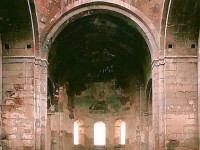The Church of Aruch
The village of Aruch is located in the Marz (region) of Aragacotn, at the southern foot of the mount of Aragats, 23 km west from the city of Ashtarak. Aruj is an ancient settlement. In the early Middle Ages was one of the stops of the Armenian Army for winters and the residence of the Armenian count (the title count of counts) Grigor Mamikonyan. The Cathedtal St. Grigor of Aruch is one of the magnificent monuments of the Armenian architecture. It is one of the largest monuments in Armenia and was built in 662-666 by the count Grigor Mamikonyan and his wife the countess Heghine. They left the inscription about that on the wall of the cathedral. The cathedral was consecrated by the Catholicos Anastas I Akoretsin (661-667). There was another basilica church in Aruch, befor the St. Grigor church was built. The priest of that church Giorgous participated in the III church meeting of Dvin (609). Later that church was converted into a secular building. The domed hall by its size (17 m - 34,5m) is of particular significance. It is distinguished by grave internal space and the dome supported on the crowned pillars and sails. It was enlightened by abundant light penetrating through the 41 windows and two wide doors. The entrances are on the northern and south-western sides. There are two triangular cavities in eastern facade. The ornaments of the cornices are woven. There are frescoes in the cathedral, which have been preserved since the 7th century, but they are now extremely depleted. There is pictured the scene of Ascension. At the top of the main altar, with the height of 7 meters is pictured Christ, with a parchment scroll in his left hand, on which is written a passage from the Gospel of John: “Every one who hath my commandments and keep them, he is that loveth me; and he who loveth me, will be loved by my Father, and I will love him too, and will manifest myself in him” (John 14:21). Some details of the image were gilded. The pedestal is covered with beautiful patterns, under which the painter's name is written - Stephanos, who is known as the first painter of the 7th century. Below, on the northern side are pictured six preachers with books. According to Hovhannes Draskhanakertsi's legend Grigor Mamikonian once built a palace-residence at the south-eastern part of the cathedral of Aruch, which was discovered during the excavations in 1948-1951. By its form, it was like a Catholicosate of Dvin. There is an inscription of 867 in front of the southeastern vestry, which evidences that the count Smbat Bagratuni regulated the water use dispute between the villages of Aruch and Kosh. In 970 the church was destroyed by the strong earthquake, three years later was rebuilt by the count Guram – by the hands of Master David. According to the inscription on the northern wall of the church, the King Smbat II Tiezerakal (Conqueror) gave tax privilege to Aruch. According to the inscription on the facade of the southern entrance of the church, the residents of Aruch were exempted from the taxes in kind in 1285. In the 15th Khachatur Vardapet (teacher) renovated the church, which collapsed a short time later, probably as a result of the earthquake. In the 16th-20th centuries the church was half destroyed and abandoned. In 1946 the destroyed parts of southern and western walls, cornices and roof were renovated. The mausoleum of the Bronze Age has been preserved, the remains of an old castle and the 13th century caravanserai in the area.


















